Photos By Kevin Wing and Ray Gauger
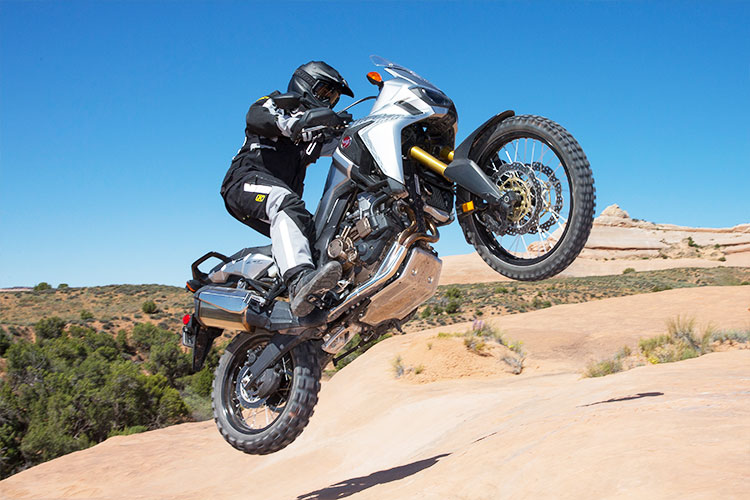 The 10-things you need to know about Honda’s re-birth into the serious off-road adventure market.
The 10-things you need to know about Honda’s re-birth into the serious off-road adventure market.
“True Adventure” is the term Honda is using to describe the performance and development goal for the CRF1000L. It’s roots can be traced back to the XRV 650 and 750 from the late 80s and early 90’s. But the current explosion of growth in the adventure segment re-ignited the need for this bike in the lineup. A little slow to the game and even slower to the US (something that is compounded by the Kumamoto earthquake that severely damaged the Honda production plant), the bike has created a lot of hype and rightly so. We got a couple of days on the bike both on-road and off in Moab, Utah and here is what we learned.
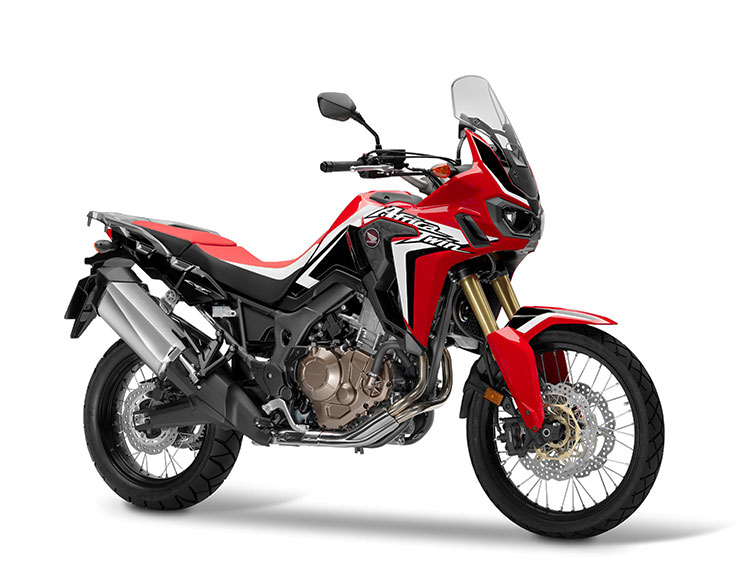
The price is low:
The base price is $12,999 and the DCT equipped bike lists for $13,699 in a world where getting a quality off-road capable bike for under $18,000 is a rarity. A one-piece steel frame, smallish footpegs, small footpeg mounts, rubber brake lines, tube-type wheels, cables for clutch and throttle body activation, non-fly-by-wire traction control and an ABS system without lean-angle corrections built in are all cost down “features” that grace the Africa Twin. But you do get easy to use and learn ABS system and traction control (Honda calls it torque control), spoked wheels, a skid plate, handguards, tapered aluminum handlebars, fully adjustable suspension, two-position seat for a price that is hard to ignore.
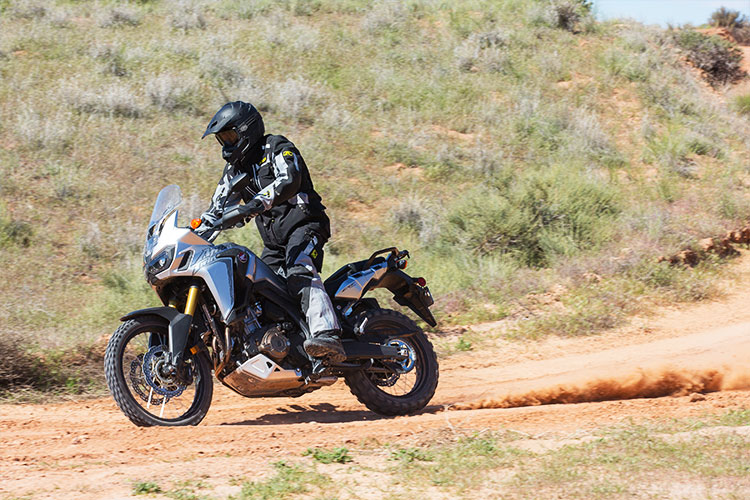
The motor is brilliant for its intended purpose:
At 999cc the in-line twin with its 270-degree phase crank is designed to give more of a V-twin power style and a unique sound as well as a narrow area more in the center of the bike where your legs and feet are positioned. It’s dual 44mm throttle bodies provide very crisp throttle response and the sound when they open wide rivals that of a finely tuned high-revving Trophy Truck at 7000 RPM and up. But this engine also has that very smooth delivery of power where it builds without any spikes, hits or surges of torque or horsepower. Very diligent and progressive. It pulls like a 1000cc bike should, with authority but lacking some standout “Oh Boy!” part of the delivery until you are ready for it. It is all good and very purposeful and useful at any RPM with astonishing lug-a-bility reminiscent of Honda XRs. We averaged about 38 MPG being very aggressive on the bike but see no reason a conservative rider couldn’t average in the mid-40s for MPG.The fuel capacity is just under five gallons.
The throttle to power delivery is very one-to-one with no surprises either. The rev cut is sudden but way far out there for such a torquey motor. The different traction control modes are easy to use and if you like having the bike limit the power with a fuel/ignition type cut then you can select how much you want TC to come into play. We rode almost exclusively with it disabled (which can be done on the fly but must be done every time the bike is shut off.) Bikes with fly-by-wire are much smoother here and seem to work better and this is an area the Honda can improve. But for delivering the power to make a smooth, minimally vibrating liter bike Honda has hit the mark perfectly. Once you realize the lacking of character can be corrected with aggressive throttle application you start doing things on the bike that you may be intimidated with on other more powerful bikes for sure. It is a little slow when compared to the 1200cc monsters out there but it would never get left behind. The six-speed gear box is well spaced and has the right range, slow to fast. We easily say over 100 MPH in the dirt and a bit more than that on some pavement that allowed it.
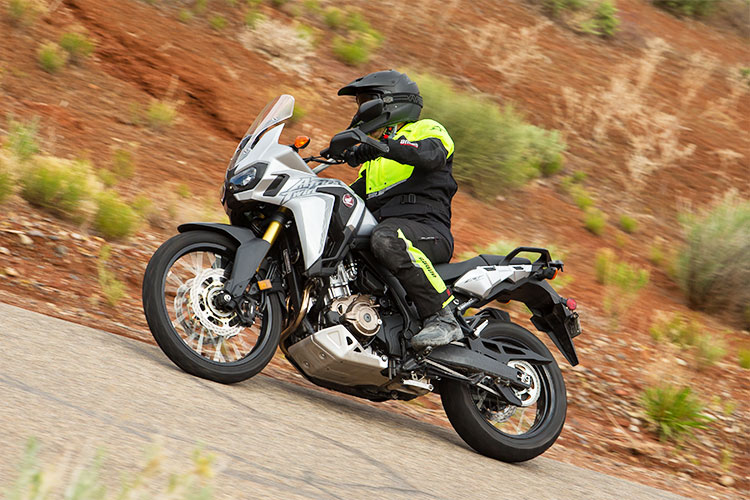
The automatic transmission in a motorcycle:
The DCT (Dual Clutch Transmission) CRF1000F available for an additional $700 is amazing. Now I know that a fair amount of motorcycle riders poo-poo any new technology saying it makes the motorcycle less of a motorcycle. But I don’t see many of them singing the same horror stories about electric starting, disc brakes, fuel injection and many other technologies, especially the aftermarket clutches that are now so popular. Mark my words–automatic transmissions and automatic clutches are just getting started and they are the future. Honda’s DCT is not perfect and it is in a very early stage from what I can tell, but for a bike like the Africa Twin that is built around being very comfortable and easy to ride the DCT is a perfect match. It nearly eliminates any possibility of stalling since you have no clutching whatsoever to worry about. It can shift the transmission smoothly, almost seamless in a few different modes and it definitely identifies what you as a rider are asking of the bike based on throttle position and RPM and does a better job than most riders I know. The Africa Twin introduces a new “G” button feature that “feathers” the clutch less than standard for a harder bite as well. Additionally a rider can select a 100% manual mode where shifting is done with the left forefinger (upshift) and thumb (downshift) which takes a little while to relearn but is simply magical once it comes online in a rider’s mind. The DCT will just not let you forget to downshift when you get too low of an RPM (it does it for you) and can also be overridden in any mode with hand shifts. Some learning on how the bike responds in different modes and which modes you as a rider prefer can pay off but in reality most riders can just leave it in the basic D mode and be very satisfied. All the while learn how much torque the bike has and how efficient it can be when it has you in third gear 15-feet away from a standing start and in sixth by the time you hit 35 MPH. I would buy the DCT bike in a heartbeat over the standard. It is that good and one less thing for me to bother with while riding.
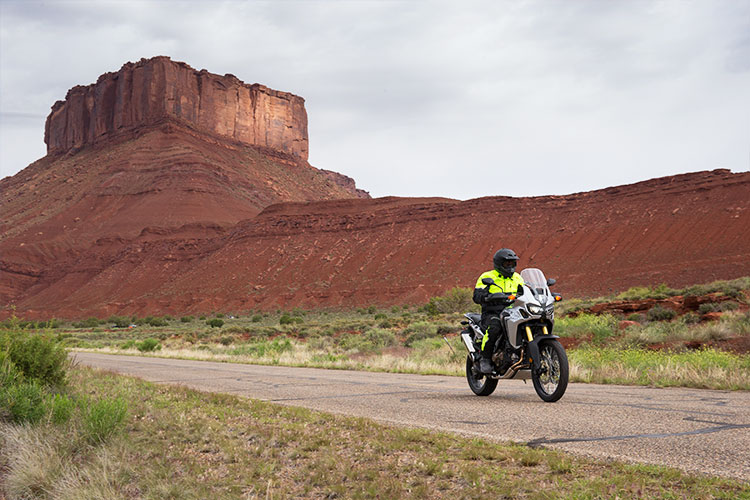
The ergos are very well positioned but there are some issues:
The small pegs (especially with the rubber cover still installed are slippery and limit the control and leverage you have on the bike –we removed the rubber for off-road riding). Additionally the buddy pegs will bump into the back of the rider’s boot with anything over a size 10 boot when getting on your toes. Luckily they are easily removed if you don’t need them. Otherwise the stock handlebar position is set very low (great for sitting only when riding) but it is easily rotated forward just a bit to raise and make standing very comfortable. The low seat is great for putting a foot or two on the ground but at 5’10” I liked the taller position since it made the rider compartment feel more spread out. The CRF is very thin at the front of the seat and the area you grab the frame with your ankles is tapered slightly outward and good for control even if the footpegs do not help at all. The windscreen does an amazing job for its size. Instruments are easy to see and use and look good too. The DCT bike has a parking brake (it is always free-wheeling when the engine is off) that is easy to use when needed.
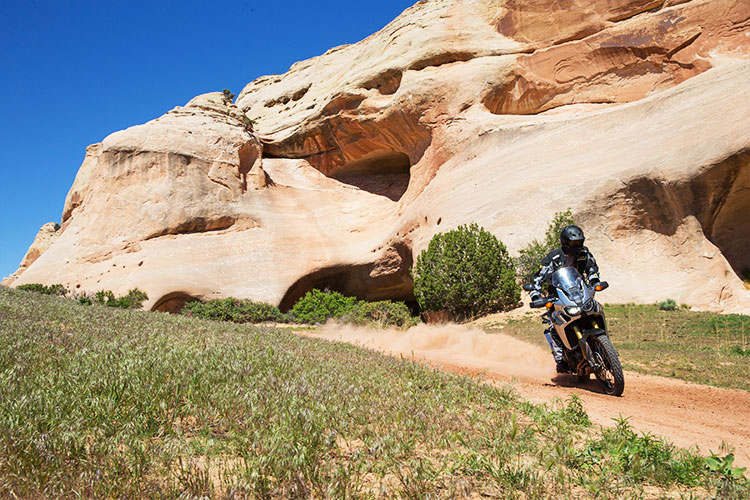
The bike is light and heavy at the same time:
At a claimed 511 pounds for the standard and 534 for the DCT CRF the bikes are in that normal twin-cylinder adventure range. But it has become apparent that with chassis design and different engine placement as well as configurations there is a lot of tuning to make the bikes feel light yet stay stable. The Honda does that pretty well and here is how it works. Light and thin off the stand and in the parking lot but a rider will notice the handlebars have a heavy feel in turning, That could be some of the longish trail feeling and a bit of a raked out feel. This really helps the stability (which the bike has plenty of) but gives a heavier handlebar turning feel. Some even call this a top-heavy feel since they put a lot of weight up onto the handlebar when turning. But in side-to-side movements the bike is fairly light and it stays very active and lively in handling when the bike is controlled through the smallish thin cheap steel footpegs (can you tell what our first modification to this bike would be?) It is easy to move around on so getting a rider’s weight to compliment the bike is easy. As the speed picks up the weight goes away and the bike becomes agile yet planted to the ground. It is easy to control slides in the dirt and it tracks well on all surfaces. And like a lot of adventure bikes it feels and acts light (the suspension really helps here and we’ll get to that) until it doesn’t when things get out of line or crazy in the bumps. We saw and heard of a few of the journalists getting caught out by this but it is pretty normal when you forget what you are riding. A 500-plus pound adventure bike, not a dirt bike.
There is obviously a lot of chassis flex tuning built into the steel frame and the very small and thin engine mounts (six of them) show it is a tuned design. One great thing about the frame is that it is a full cradle so there are tubes doing some protection (along with a skid plate) as well as tying the chassis together without the use of the motor as a stressed member. The rear frame is not removable like it is on some bikes.

This is the best suspended adventurer bike we’ve ridden:
Plain and simple the CRF1000 has great suspension. It is fully adjustable and we don’t know too many of the specifics about the internals because that isn’t something touted too much in the adventure world. But Honda really spent some time getting it tuned and it allowing it to be very adjustable with range to be set up for a lot of conditions. Standard is more for the street to make the bumps go away and here it does that as well as letting the bike settle in the stroke and stay planted in the twisties. Off-road our bikes were stiffened up a bit across the board on spring preload, compression and rebound and it really worked well. The bike is not choppy or harsh and does not ride to low in the stroke to where it gets into the stiffer part of the travel. It is loose and springy enough to take the bumps out and get traction on the washboards without feeling wallowly in real bumps. The biggest surprise and performance advantage was the bottoming or lack of it. When this bike is ridden acceptably aggressive for what an adventure bike it rarely bottoms out and when it does it is by far the most controlled bottoming, especially when it rebounds.
Don’t worry, you can bottom it but you have to be going too fast or doing something out of the design parameter of the bike. Don’t believe us, eye the top shock mount (very thin and not too braced) and the diameter of the shock mounting bolts (8mm) and that should give you an indication of the forces they expect the to be put through the CRF’s shock and into the frame. Most off-road bikes of half the weight use at least 10mm hardware for shock mounting. When you hit a very sharp bump (not even bottoming) you can get an audible slapping of some of the front bodywork or rear chain and muffler cover that makes a bottoming type sound but it isn’t indicative of what the suspension is doing even though some were obviously confused by this. That said the Honda is also one of the least clicking and chattering of body parts making noise that we can remember, the build feels very solid.
We did some quick tuning of the suspension for off-road above and beyond the great setting that Honda has come up with and by adding even more preload and a slight tuning of the compression (more in the rear) and rebound (less in the rear) got a setting that we’d classify as a sportier setting even if it lost a bit of the comfort. One question will be durability of the suspension parts but only time or a more detailed explanation of the components will reveal that. Both front fork and rear shock appear to be fully rebuildable.
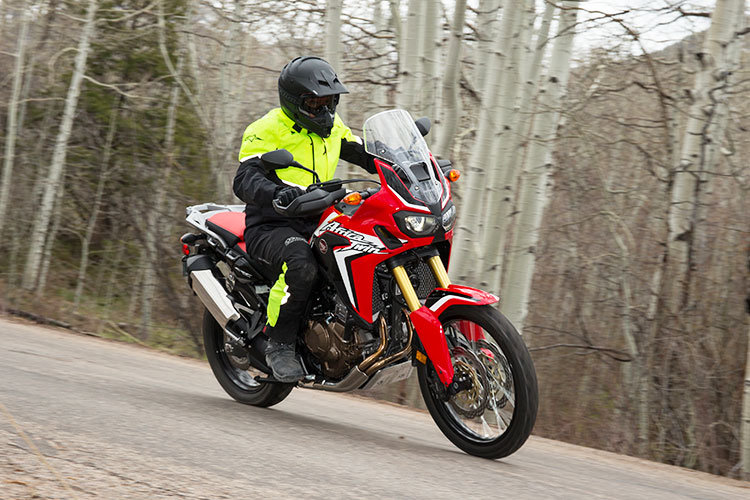
The stock Dunlop tires are in no way an off-road tire:
Having manufacturers of adventure bikes continually putting street tires on a bike intended to go off-road just confuses those that don’t know any better. We know there are a lot of reasons for the tire (smoother on-road ride and sound compliance) but the tire does not fit with where Honda positions the bike. So much so that Honda outfitted the bikes with Continental TKC80 knobby-type tires for our off-road riding day which was a wise and brilliant move. Don’t expect the stock tires to do anything but get you in trouble once off the pavement. Especially when you need them to work.
Bits and pieces:
The overall build and user interface of the bike, from the brakes to the way the buttons are positioned on the bike are simple to learn and friendly to use. Nothing stands out or bothers too much aside from the points we already mentioned. The ABS is always active in the front but the rear can be disabled for off-road use. It isn’t the quickest reacting system nor are the brakes the strongest but they are excellent none the less. There is good adjustability of the brakes and the feel is good. The seat foam felt pretty decent to us but we were standing a lot on our off-road day and only in the saddle for a half-day on-road. Honda has a line of parts and accessories already available for the bike and we’re pretty sure stuff will be popping up as quickly as the aftermarket gets bikes to play with.
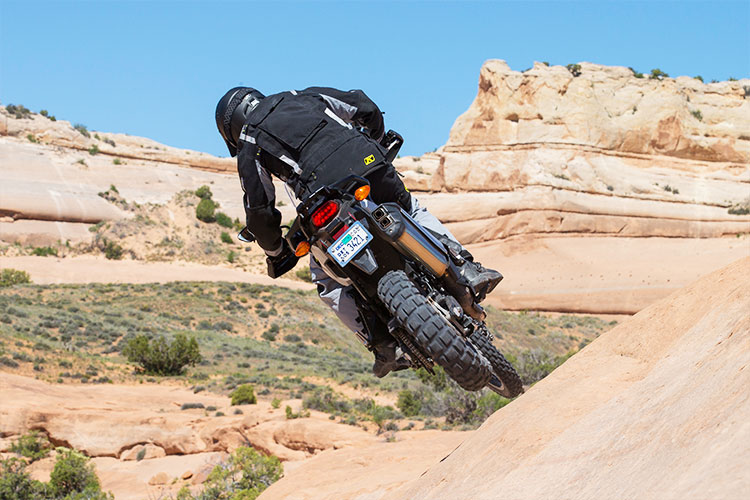
Can you get one?
Well the first batch is on the water and we were told there will be at least one to each dealer in June. We know those are all spoken for with deposits. Then there is the issue of the factory being shut down mid production run from the earthquake. So a few will have them in June and everyone else may have to wait an undisclosed amount of time. Almost a month post earthquake the factory is still only at limited production.
How good is it?
Frankly we were expecting the Africa Twin to be pretty good–but not as good as this initial impression has us believing. It gets two thumbs up without hesitation. Just previous to going on this intro I had spent plenty of time on KTM’s 1190s and a KTM 950 so I was very familiar with being on big ADV bikes. The CRF1000F is truly most comparable to a KTM 990 in motor and the KTM 950S (long travel) in suspension and handling performance and that is a big plus for a lot of riders who were not so thrilled with the trend for massive power and less off-road performance. Honda placed off-road use high on the list and it shows. Yet is it still a wonderful on-road upright sitting position touring bike for which most riders will actually use the Africa Twin for. We’ll be getting a bike for a full test soon and we can dig deeper into the technology and path Honda has chosen to chase what they call true adventure.
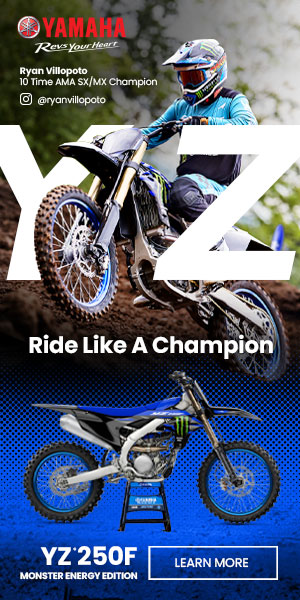

8 Responses to “2016 Honda CRF1000L Africa Twin First Riding Impression”
Christian Parker
Good write up. I’ve seen this bike in person (at the IMS show) and the price point seemed to match the fit and finish. Not a ton of tech happening aside from the DCT, but that will fit with allot of wallets and intended uses. I never thought this bike would be a flop and the reviews seem to be mirroring that sentiment. Now let me take one apart!
Tümer Gündem
Very clean nice review…
A few questions here;
1. What about the price of vulnerable parts in an off road crash or tip over position?
2. Long Term endurance review (as ben told up there)
Thanks a lot for riding and put effort in this evaluation.
Peace.
Jimmy Lewis
This was just an initial impression and when we get a bike to test we will look into parts prices but I suspect they will be average. There is nothing extra to break compared to other bikes.
Tümer Gündem
Thx.
Scot Harden
Jimmy, What about heat coming off the motor. The biggest knock against my 1190R is the heat it generates and radiates on my inner thigh and legs. During the summer months it can be downright bothersome especially on long stretches of highway running. How did the Honda perform in this regard?
Jimmy Lewis
I did not notice any heat bothering me. Without a rear cylinder there are less hot things there.
Rob
all would be good if there’re not poor build quality issues…
Shane
I had a sticking set button replaced on warranty.